





Water gardens don't have to be large in-ground koi ponds. Many of us don't have the room or money to dig up our yard and build a pond. Maybe your health keeps you from being outside as much as you like. Or you want to bring the joy of water gardens into your house for constant enjoyment. Here is a basic overview of fancy goldfish and indoor water-gardens.
Many people have an aquarium, but it can go beyond gravel and a bubbling treasure chest. It can be your indoor water garden. You can keep whatever aquatic life you like in your water garden, but I love fancy goldfish the most.
Fancy goldfish are my favorite because they have such cute faces and unique personalities. They are smarter than people think. They can even learn tricks. Fancy goldfish will relax you and amuse you for hours with their acrobatics.
Fancy goldfish will get quite large if they are treated well. Most varieties can grow as large as 6 to 10 inches long. In some cases they can get even larger. They could even out live the cat. Their lifespan in the aquarium is around 8 to 10 years. In the pond, fancy goldfish can live to around 15 years. This group of fish are cold water fish; they are happiest at 60 to 75 degrees Fahrenheit.
Your fish will need a diet rich in protein supplemented with veggies at least once a week. Peas help with digestive issues that fancies sometimes have due to their compact bodies; just remove the pea skins. I've also used cooked cauliflower, broccoli, and spinach.
The Fish
Goldfish are descendants of the domesticated Prussian carp. They were domesticated by the Chinese 1,000 yrs ago. Selective breeding has given us the colors and varieties we see today. To me the fancy gold fish is the most magnificent fresh water fish. It started when I was ten and saw a huge oranda in a pet store and proceeded to beg my mom to get it. The only problem is you may get addicted and find yourself looking for ''another tank''.
The Oranda
The Oranda is one of the most widely recognizable fancy goldfish, and have a head growth called a wen. The wen can either be on the top only or the gills and cheeks also. Sometimes they are compared to aliens but i think their chubby faces will brighten your day.
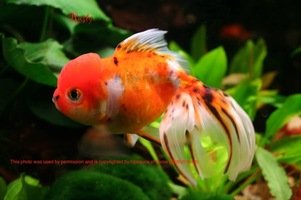
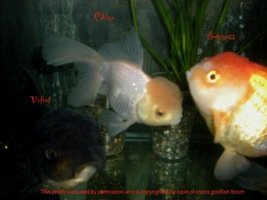
The Fantail
The Fantail is one of the most common fancy goldfish. They don't have a head growth and they have a sort of diamond shaped body. They are faster swimmers than most fancy goldfish and can do well in a pond.
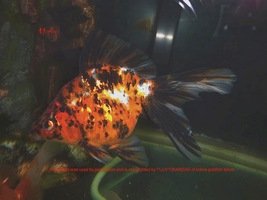
The Ryukin
The Ryukin is a powerful looking goldfish. The presence of a hump directly behind their head gives them a muscular, hulky look that commands attention. They have deep bodies and the hump gives the dorsal fin the look of a mohawk. Ryukin can have short, long or broad tails.
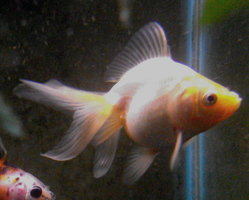
The Ranchu
The Ranchu is my favorite. They have a wen and do not have a dorsal fin. The Ranchu may very well deserve an article all their own because of the culture tradition and variation of this fish. There are different types, depending on where the fish came from, including Japanese, Chinese and Thai Ranchu. Typically Japanese Ranchu, also called top view Ranchu because they are seen from above in a pond, have a longer back and a more square shape to the wen. The Chinese Ranchu, also called side view Ranchu because they are bred to be viewed from the side in the aquarium, have a fuller wen and a high arch to their back. Thai Ranchu are bred in Thailand and have a Japanese lineage.
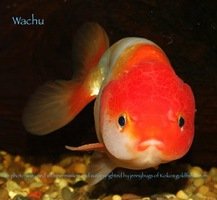
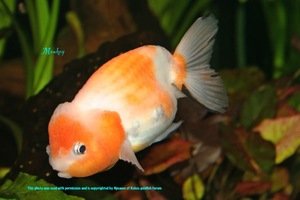
The Lionhead
The Lionhead is very similar to the Ranchu. There is not much difference to the untrained eye. The Lionhead originated in China and has a straight back and a full wen.
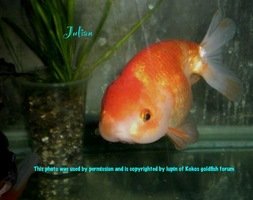
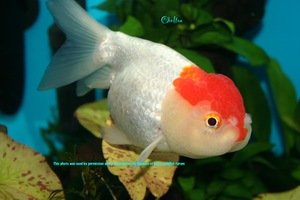
The Telescope group
The Black Moor is a very beautiful and easy-to-find fish. Care needs to be taken with their telescope eyes. They are best kept with slower fancies like the Oranda and the Bubble Eye. A true Black Moor will stay black, but with so much cross-breeding you may end up with a multi-colored fish as the black pigment is the most unstable. One that isn't a true solid Black Moor is called a telescope. They can also come with broad tails or butterfly tails.
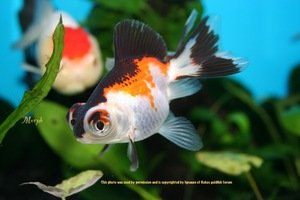
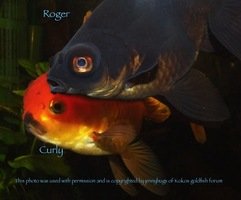
The Bubble Eye
This is a comical-looking variety of fancy goldfish, with bubbles protruding from the eye sockets. They have no dorsal fin. Bubble eyes are delicate; make sure there are no sharp objects in the tank that could pop the bubbles.
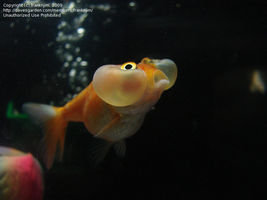
The Pearl scale
This is a very cute but delicate variety. They have raised bumps on his scales that look like pearls; if a scale should get torn off, a flat one will grow in its place. No sharp objects or things that may injure the scales should be in the tank. Pearl scales can have a wen--these are called Crown Pearl scales. The ones without a wen are called golf ball.
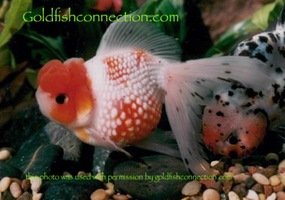
These are the varieties that are most commonly found in the pet store. Less-common varieties are Veil Tail, Tosakin, Celestial, and Pom Pon; they can be calico, black, red and white, red and even blue.
Flowering Plants
It wouldn't be much of a water garden without plants, and there are plenty to choose from. Best of all, you get to view the plants from all sides and grow flowering plants in the dead of winter.
Sword plantEchinodorus are easy-to-find and grow. Sword plants have a moderate growth rate and will send an inflorescence out of the water to flower.
Heteranthera dubia
This is a true aquatic fast-growing plant. It is happy in most aquarium settings without any special care. It will produce small flowers just under the surface of the water.
Sagittaria subulata
This is a moderate grower with a medium height. This plant will look great in the foreground or middle of the plantings. This plant sends a stalk to the surface to produce a small, white three-petaled flower.
Tape Grass
Vallisneria spiralis, also known as tape grass, is a grass-like plant with flat curly leaves. It is easy to grow and multiplies by spreading runners. The flowers on this plant grow to the surface and bloom just under the water. This is a great plant for a goldfish home because it does well in alkaline water.
Anubias barteri var. nana
This is another easy to find plant. It is easy to grow because it does well in moderate light. It likes to be attached to driftwood or rock but I've had luck just planting it.
These are a few examples of flowering plants that will do great in a goldfish habitat. Just be careful not to use mondo grass or other non-aquatic plants that the pet stores sometimes sell. They will die in the low light, and rot in the tank. There are many sources to find aquatic plants if your local pet store doesn't have them. Just search PlantScout and The Garden Watchdog for sources.
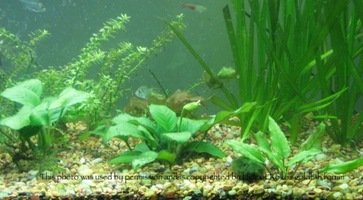
The House
You've probably been thinking this whole time that this only applies to glass aquariums, but there are other options. You can have an indoor pond! Just make sure the children are older and you don't have a bad kitty or thirsty dog. Fancy goldfish need a minimum of 15 gallons per fish, so plan accordingly. If you overstock, you will have water quality issues and you will lose some fish.
For an indoor pond you could use any thing that is fish safe and holds water. A pre-formed pond liner, plastic livestock trough, or a large plastic tote will work. Pick your location carefully because it will be pretty permanent. Make sure it is out of the way of traffic and drafts. Next decide how you want to mask the liner. You can stack rocks or bricks up around the outside or you can frame it with a plywood box. If you decide to make a box for it, you can tile it or mosaic it. You can get really creative. Just make sure you leave room in the box for the pumps and filters. After its all together and decorated how you want it you can add the water. Just be sure to clean up all debris from your project and never use soap to clean a fish habitat. Once it is full and the filtration is set up, you can cycle your indoor pond and search for your dream fish.
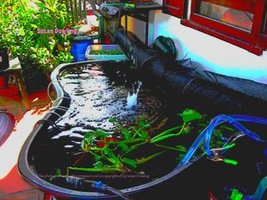
Water Quality and Filtration
Water quality is a very important issue. In fish keeping there is something called the nitrogen cycle. Fish excrete ammonia and the beneficial bacteria in the filter turn the ammonia to nitrites. A second set of bacteria turns the nitrites into nitrates, then you change 30 percent or more of the water each week. Without the complete cycle and both types of beneficial bacteria, the ammonia will build up and the fish may die. Cycle the tank by setting it up and letting it run without the fish. Add some live bacteria; it is very inexpensive and available everywhere fish products are sold. After you add the beneficial bacteria, feed the tank as if there were fish in there. The decaying food will feed the bacteria. The colony of both types of bacteria will continue to grow in your filter. You will need a test kit to monitor the rise and fall of the ammonia and the rise and fall of the nitrites. Once you have zero ammonia and zero nitrites and a bit of nitrates you have a cycled tank. Keep in mind to test it again after you add the fish as the bacteria will possibly need to catch up to your fishes bio load. Add only one fish at a time at least a week apart to let the bacteria in the filter catch up. This is a very basic overview but you can visit Koko's Goldfish Forum for more information and help with any problems you encounter.
There are many filters on the market today; do a bit of research to find the best type for your needs. You might already know that goldfish produce a lot of waste. It seems like way more comes out than goes in. You may be surprised to learn your filter needs to turn over ten times the volume of water each hour. That means if you have a 55-gallon tank your filter need to turn over 550 gallons per hour. This might seem like a lot; but if you go much lower, your water quality will suffer and you will be doing bigger and more frequent water changes. If you have a large amount of water you may need two filters.
There is much to think about, and many options to consider if you love water gardens but don't have the space outside for a large koi pond. You can have a wonderful water garden with flowering plants inside your house. You will enjoy the company of these lovable sweet creatures known as the fancy goldfish.
Sources
Fish sources: Goldfishconnection.com offers show quality fancy goldfish and pond fish. they also offer premium goldfish food and medications.
Raingarden.com offers fancy goldfish and tropical plants. They have a good reputation and shipping rate.
Plant sources: Liveaquaria.com has a good selection of aquatic plants and other supplies.
Photo credits
I'd like to thank the following people for being so generous with their knowledge and photos. These photos are used with permission given by the owners of the photos. The photos in this article are property of the people listed below and unauthorized use is prohibited.
Copyright © www.100flowers.win Botanic Garden All Rights Reserved